TOYOTA HIGHLANDER HYBRID 2008 XU40 / 2.G Owners Manual
Manufacturer: TOYOTA, Model Year: 2008, Model line: HIGHLANDER HYBRID, Model: TOYOTA HIGHLANDER HYBRID 2008 XU40 / 2.GPages: 580, PDF Size: 13.29 MB
Page 521 of 580
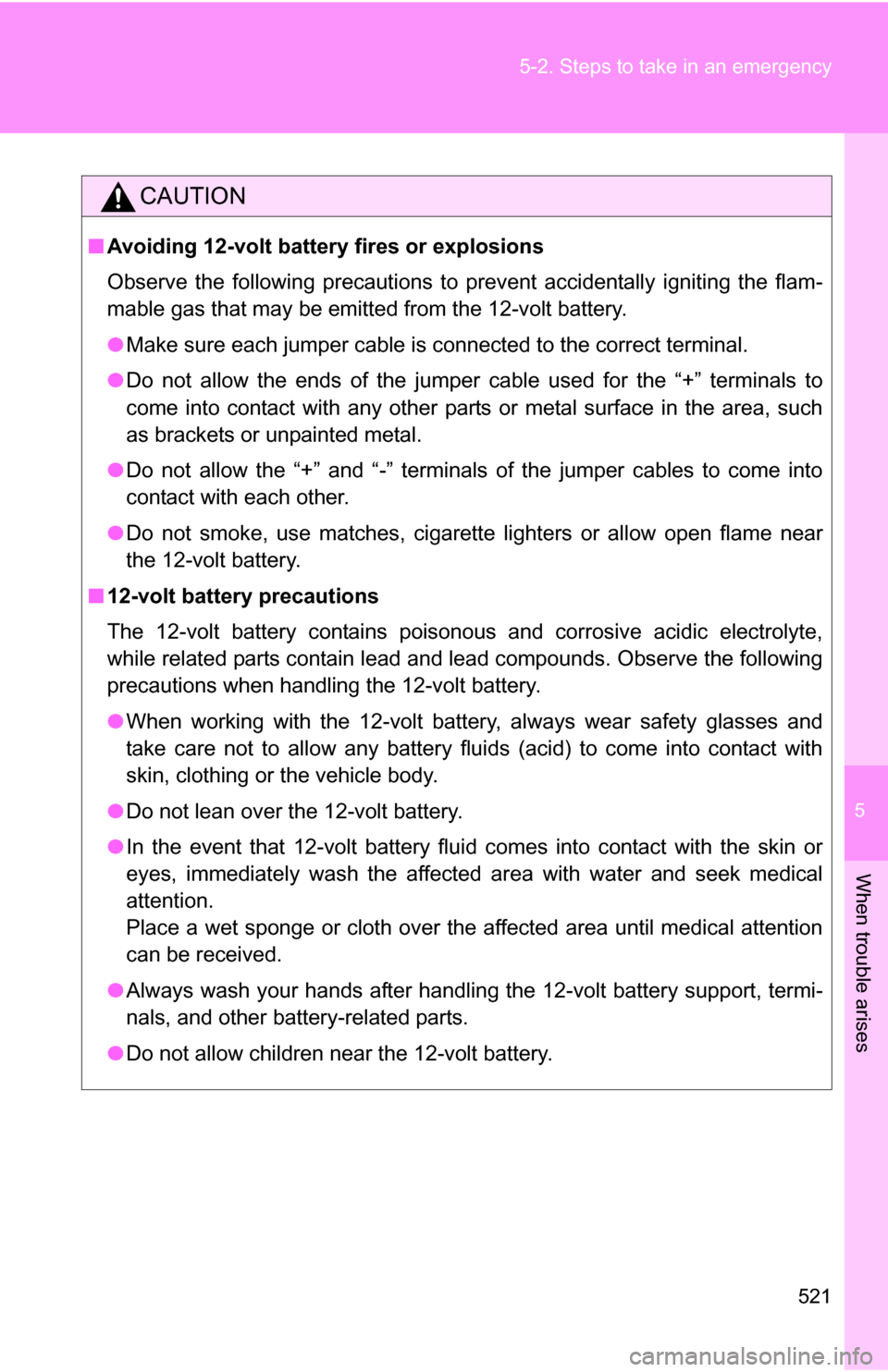
5
When trouble arises
521
5-2. Steps to take in an emergency
CAUTION
■
Avoiding 12-volt battery fires or explosions
Observe the following precautions to prevent accidentally igniting the flam-
mable gas that may be emitted from the 12-volt battery.
●Make sure each jumper cable is connected to the correct terminal.
● Do not allow the ends of the jumper cable used for the “+” terminals to
come into contact with any other parts or metal surface in the area, such
as brackets or unpainted metal.
● Do not allow the “+” and “-” terminals of the jumper cables to come into
contact with each other.
● Do not smoke, use matches, cigarette lighters or allow open flame near
the 12-volt battery.
■ 12-volt battery precautions
The 12-volt battery contains poisonous and corrosive acidic electrolyte,
while related parts contain lead and lead compounds. Observe the following
precautions when handling the 12-volt battery.
●When working with the 12-volt battery, always wear safety glasses and
take care not to allow any battery fluids (acid) to come into contact with
skin, clothing or the vehicle body.
● Do not lean over the 12-volt battery.
● In the event that 12-volt battery fluid comes into contact with the skin or
eyes, immediately wash the affected area with water and seek medical
attention.
Place a wet sponge or cloth over the affected area until medical attention
can be received.
● Always wash your hands after handling the 12-volt battery support, termi-
nals, and other battery-related parts.
● Do not allow children near the 12-volt battery.
Page 522 of 580
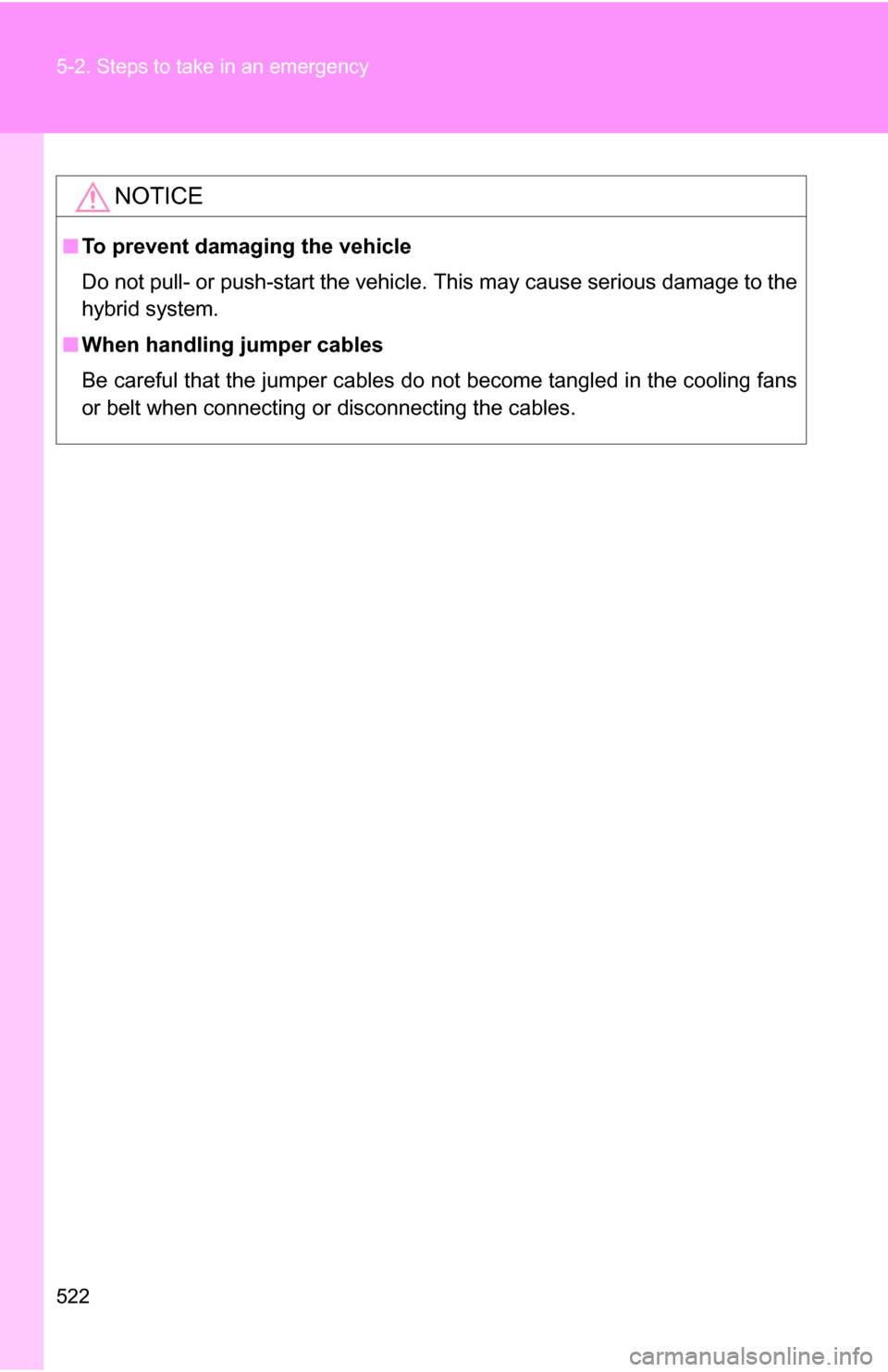
522 5-2. Steps to take in an emergency
NOTICE
■To prevent damaging the vehicle
Do not pull- or push-start the vehicle. This may cause serious damage to the
hybrid system.
■ When handling jumper cables
Be careful that the jumper cables do not become tangled in the cooling fans
or belt when connecting or disconnecting the cables.
Page 523 of 580
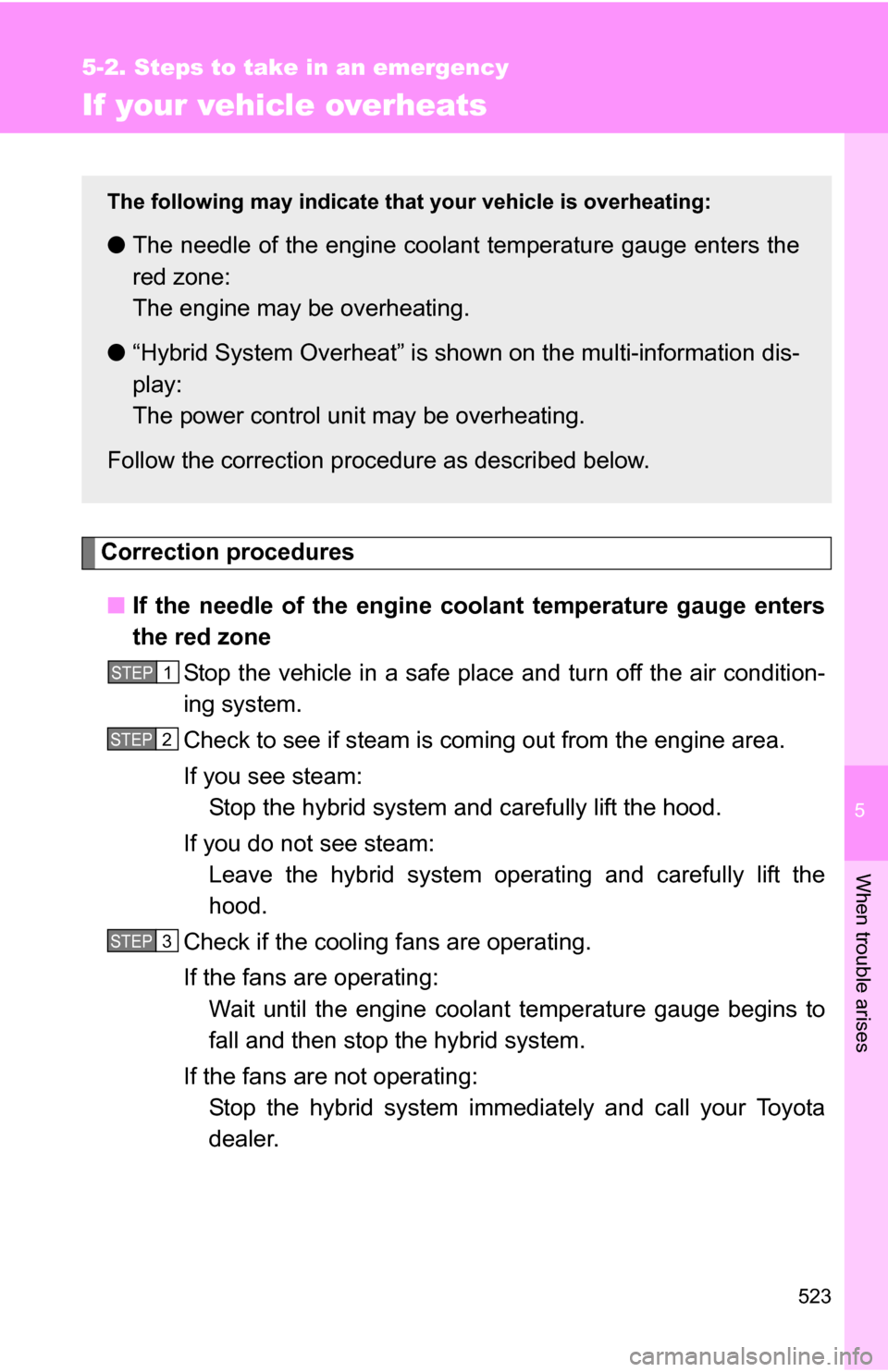
5
When trouble arises
523
5-2. Steps to take in an emergency
If your vehicle overheats
Correction procedures■ If the needle of the engine coolant temperature gauge enters
the red zone
Stop the vehicle in a safe place and turn off the air condition-
ing system.
Check to see if steam is coming out from the engine area.
If you see steam:
Stop the hybrid system and carefully lift the hood.
If you do not see steam: Leave the hybrid system operating and carefully lift the
hood.
Check if the cooling fans are operating.
If the fans are operating: Wait until the engine coolant temperature gauge begins to
fall and then stop the hybrid system.
If the fans are not operating: Stop the hybrid system immediately and call your Toyota
dealer.
The following may indicate that your vehicle is overheating:
●The needle of the engine coolant temperature gauge enters the
red zone:
The engine may be overheating.
● “Hybrid System Overheat” is shown on the multi-information dis-
play:
The power control unit may be overheating.
Follow the correction procedure as described below.
STEP1
STEP2
STEP3
Page 524 of 580
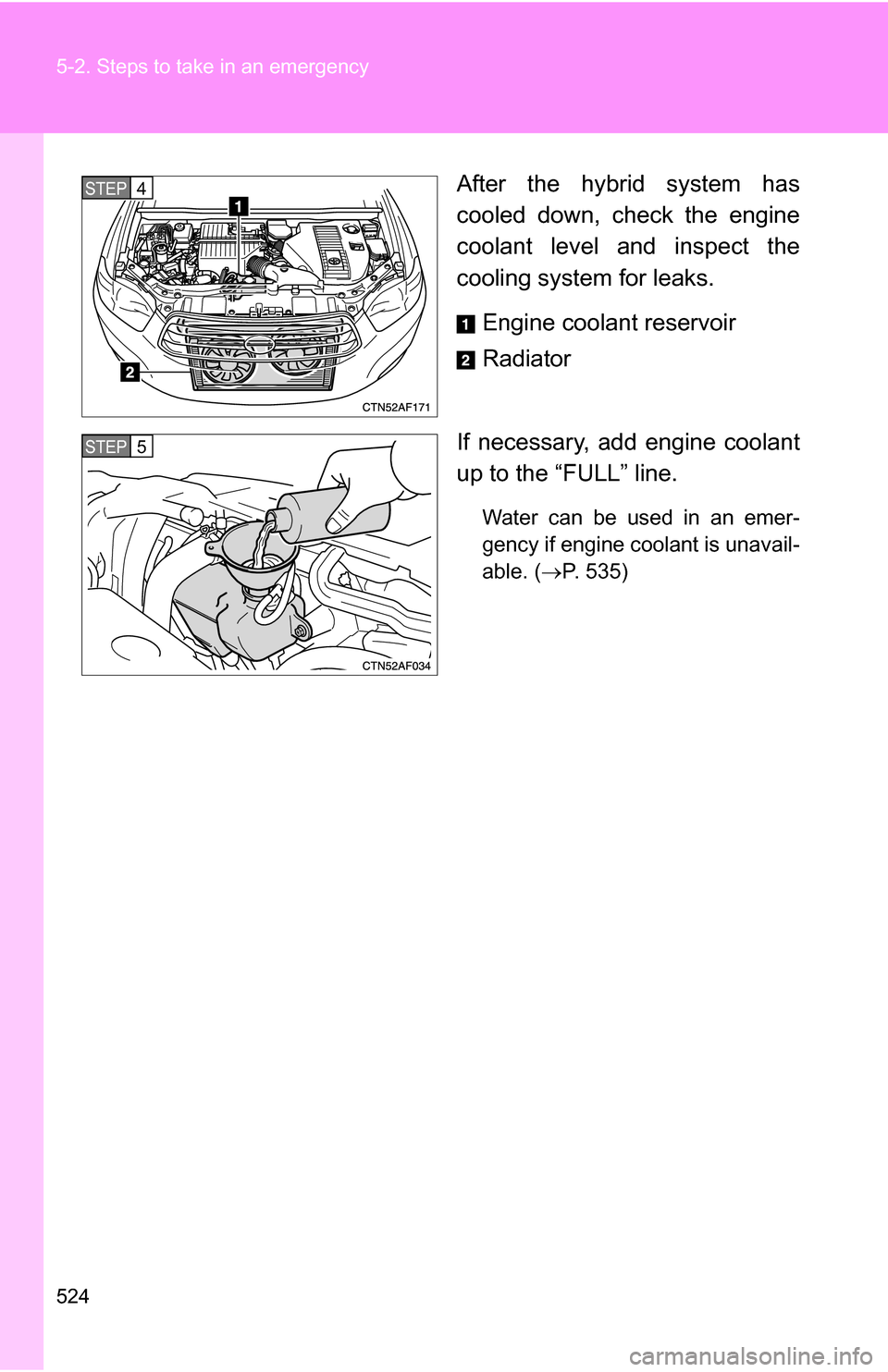
524 5-2. Steps to take in an emergency
After the hybrid system has
cooled down, check the engine
coolant level and inspect the
cooling system for leaks.Engine coolant reservoir
Radiator
If necessary, add engine coolant
up to the “FULL” line.
Water can be used in an emer-
gency if engine coolant is unavail-
able. ( P. 535)
STEP4
STEP5
Page 525 of 580

5
When trouble arises
525
5-2. Steps to take in an emergency
■
If “Hybrid System Overheat” is shown on the multi-informa-
tion display
Stop the vehicle in a safe place and turn off the air condition-
ing system.
Leave the hybrid system operating and carefully lift the hood.
Check if the cooling fans are operating.
If the fans are operating: Wait until “Hybrid System Overheat” disappears and then
stop the hybrid system.
If the message does not disappe ar, call your Toyota dealer.
If the fans are not operating: Stop the hybrid system immediately and call your Toyota
dealer.
After the hybrid system has
cooled down, check the power
control unit coolant level and
inspect the cooling system for
leaks.
Power control unit coolant res-
ervoir
Power control unit coolant
radiator
If necessary, add power control
unit coolant up to the “FULL”
line.
Water can be used in an emer-
gency if power control unit cool-
ant is unavailable. ( P. 535)
Have the vehicle inspected at your nearest Toyota dealer as soon as
possible.
STEP1
STEP2
STEP3
STEP4
STEP5
Page 526 of 580
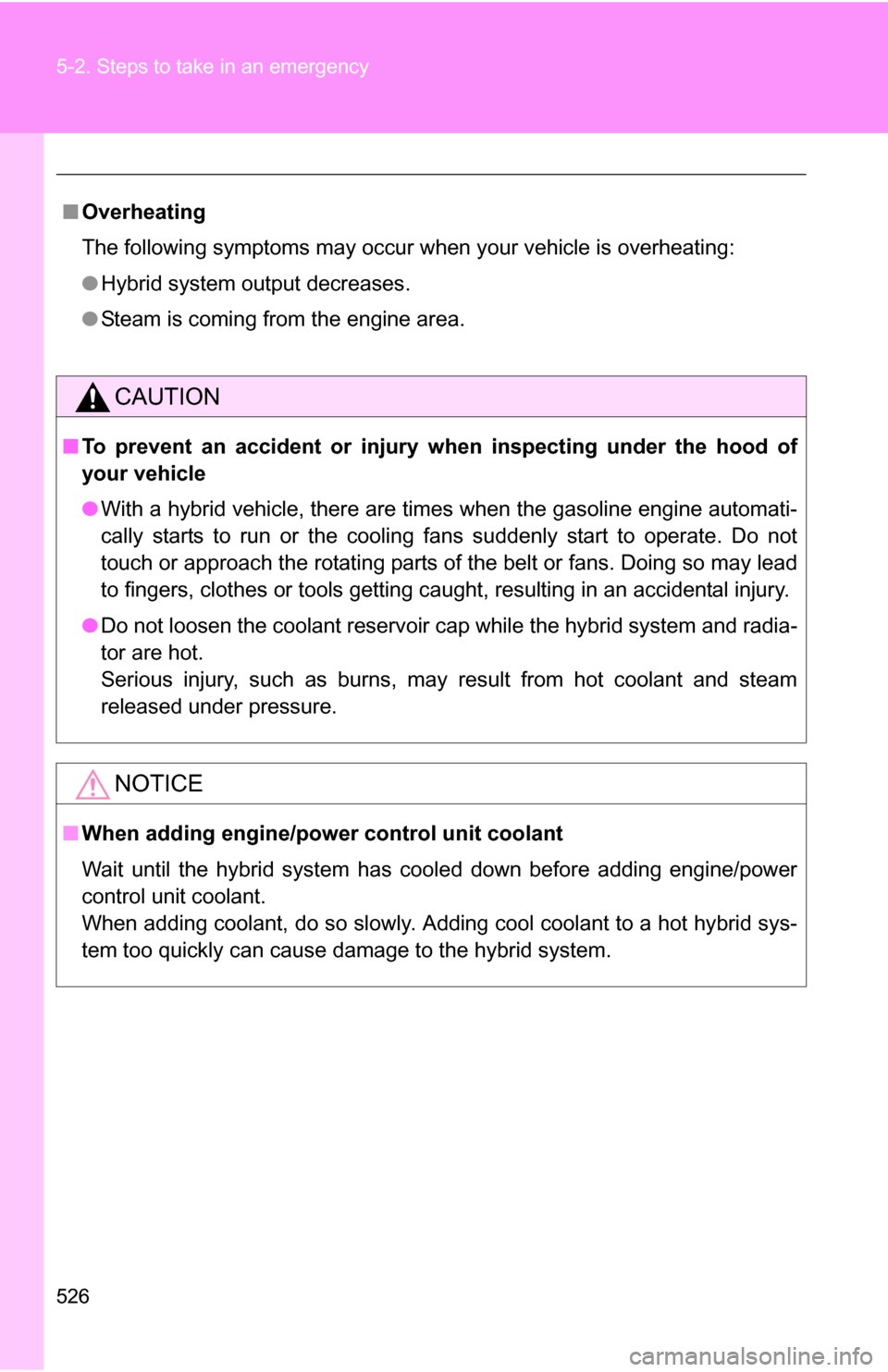
526 5-2. Steps to take in an emergency
■Overheating
The following symptoms may occur when your vehicle is overheating:
●Hybrid system output decreases.
● Steam is coming from the engine area.
CAUTION
■To prevent an accident or injury when inspecting under the hood of
your vehicle
● With a hybrid vehicle, there are times when the gasoline engine automati-
cally starts to run or the cooling fans suddenly start to operate. Do not
touch or approach the rotating parts of the belt or fans. Doing so may lead
to fingers, clothes or tools getting caught, resulting in an accidental injury.
● Do not loosen the coolant reservoir cap while the hybrid system and radia-
tor are hot.
Serious injury, such as burns, may result from hot coolant and steam
released under pressure.
NOTICE
■When adding engine/power control unit coolant
Wait until the hybrid system has cooled down before adding engine/power
control unit coolant.
When adding coolant, do so slowly. Adding cool coolant to a hot hybrid sys-
tem too quickly can cause damage to the hybrid system.
Page 527 of 580

5
When trouble arises
527
5-2. Steps to take in an emergency
If the vehicle becomes stuck
■Emergency hooks
Carry out the following procedures if the tires spin or the vehicle
becomes stuck in mud, dirt, or snow.
Stop the hybrid system. Set t he parking brake and put the
shift lever in P.
Remove the mud, snow, or sand from around the stuck tire.
Place wood, stones or some other material to help provide
traction under the tires.
Restart the hybrid system.
Shift the shift lever to the D or R position and carefully apply
the accelerator to free the vehicle.STEP1
STEP2
STEP3
STEP4
STEP5
If your vehicle becomes stuck and cannot
move, the emergency hooks are used for
another vehicle to pull your vehicle out in
an emergency.
Your vehicle is not designed to tow
another vehicle.
Page 528 of 580

528 5-2. Steps to take in an emergency
CAUTION
■When attempting to free a stuck vehicle
If you choose to rock the vehicle back and forth to free it, make sure the sur-
rounding area is clear, to avoid striki ng other vehicles, objects or persons.
The vehicle may also lunge forward or lunge back suddenly as it becomes
free. Use extreme caution.
■ When shifting the shift lever
Be careful not to shift the shift lever with the accelerator pedal depressed.
This may lead to unexpected rapid acceleration of the vehicle that may
cause an accident and result in death or serious injury.
NOTICE
■To avoid damaging the transmission and other components
●Avoid spinning the wheels.
● If the vehicle remains stuck after trying these procedures, the vehicle may
require towing to be freed.
Page 529 of 580
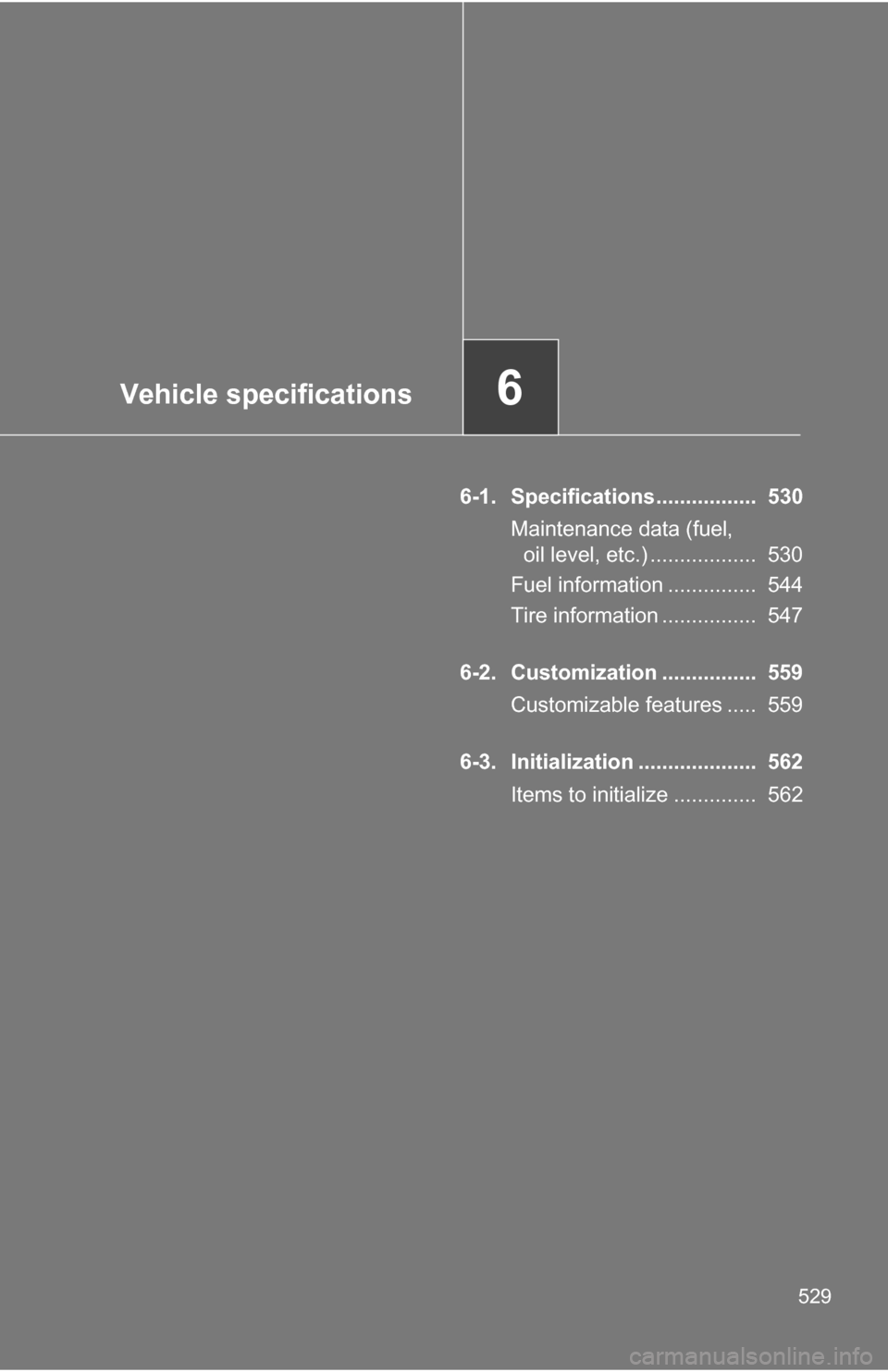
Vehicle specifications6
529
6-1. Specifications................. 530Maintenance data (fuel, oil level, etc.) .................. 530
Fuel information ............... 544
Tire information ................ 547
6-2. Customization ................ 559 Customizable features ..... 559
6-3. Initialization .................... 562 Items to initialize .............. 562
Page 530 of 580
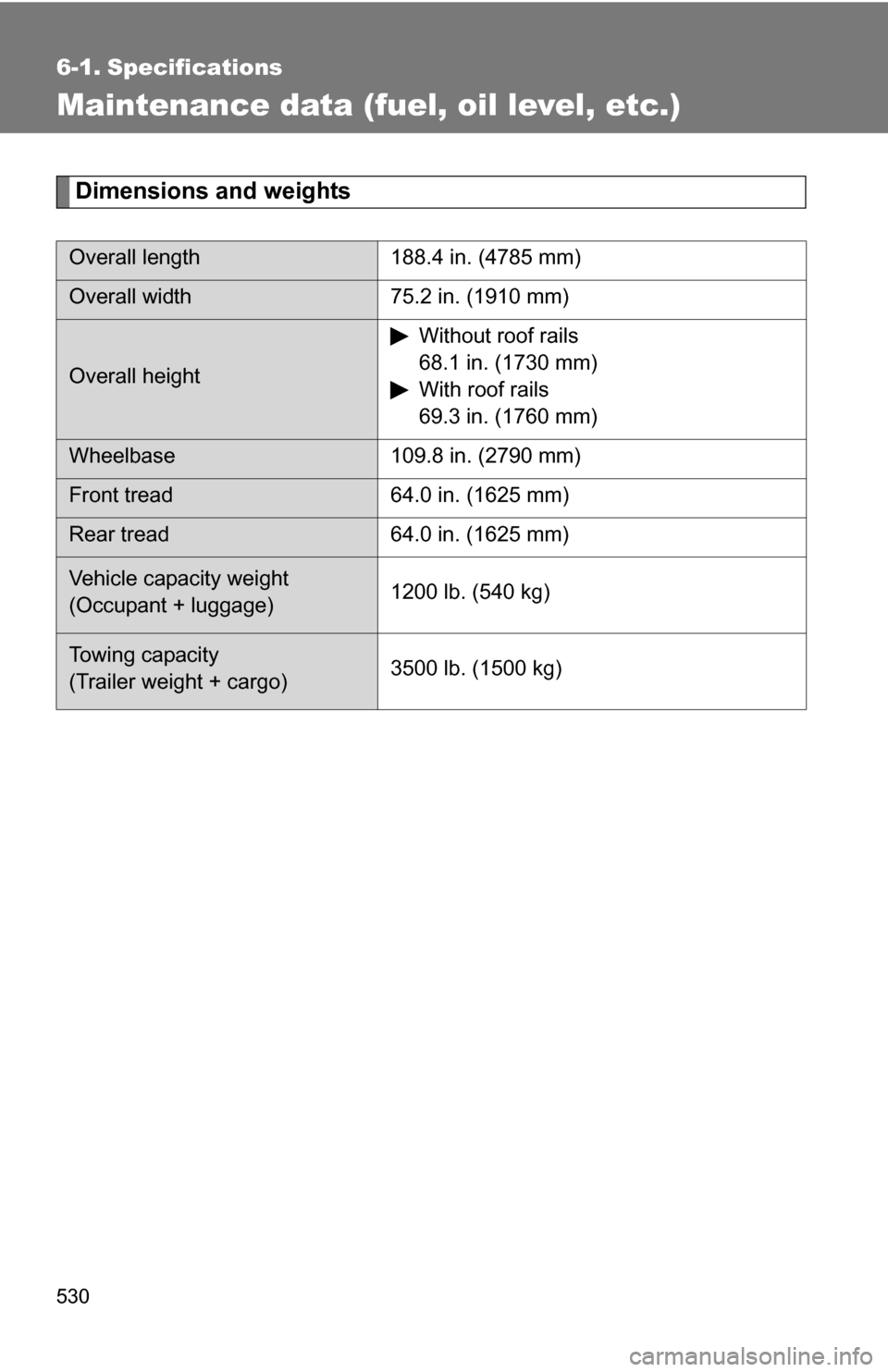
530
6-1. Specifications
Maintenance data (fuel, oil level, etc.)
Dimensions and weights
Overall length188.4 in. (4785 mm)
Overall width75.2 in. (1910 mm)
Overall height Without roof rails
68.1 in. (1730 mm)
With roof rails
69.3 in. (1760 mm)
Wheelbase
109.8 in. (2790 mm)
Front tread 64.0 in. (1625 mm)
Rear tread64.0 in. (1625 mm)
Vehicle capacity weight
(Occupant + luggage) 1200 lb. (540 kg)
Towing capacity
(Trailer weight + cargo)3500 lb. (1500 kg)